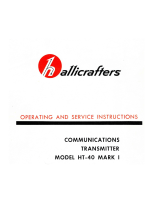
TECHNICAL SUPPLEMENT FOR THE SR-160 & SR-500 by WDØGOF August 2010
3
TABLE OF CONTENTS
HALLICRAFTERS, HAM RADIO, & WDØGOF...............................................................................................................................2
TABLE OF CONTENTS .......................................................................................................................................................................3
SR-160 OVERVIEW..............................................................................................................................................................................4
SR-500 OVERVIEW..............................................................................................................................................................................5
160/500 BASICS.....................................................................................................................................................................................6
SR-160 TO SR 500 EVOLUTION..........................................................................................................................................................6
SR-500 FINALS......................................................................................................................................................................................6
POWER SUPPLY NOTES...................................................................................................................................................................7
ALIGNMENT TIPS...............................................................................................................................................................................8
TEST EQUIPMENT CONSIDERATIONS...........................................................................................................................................8
VFO AND XTAL OSCILLATOR CONSIDERATIONS. .....................................................................................................................8
HETERODYNE OSCILLATOR........................................................................................................................................................8
CARRIER OSCILLATOR.................................................................................................................................................................8
ALTERNATE VFO ALIGNMENT ....................................................................................................................................................9
RX ANTENNA & DRIVER INPUT & OUTPUT..................................................................................................................................9
BAND ALIGNMENT INTERACTIONS. ............................................................................................................................................9
T7 AGC AMP.................................................................................................................................................................................... 10
T3 RX/TX INTERACTION............................................................................................................................................................... 10
THE S METER.................................................................................................................................................................................... 11
S METER AMP TUBE SELECTION.................................................................................................................................................11
AGC CONSIDERATIONS................................................................................................................................................................ 11
MISC NOTES....................................................................................................................................................................................... 12
TUNING FOR PLATE I DIP..............................................................................................................................................................12
RX RF AMP MOD.............................................................................................................................................................................12
RIT/CAL........................................................................................................................................................................................... 12
SR-160/500 DRIFT............................................................................................................................................................................... 13
CAL/RIT CIRCUIT CONSIDERATIONS..........................................................................................................................................13
RIT OFFSET AND RANGE TEST..................................................................................................................................................... 14
VFO CONSIDERATIONS.................................................................................................................................................................14
CRITICAL NOTE 150V REGULATOR & 240V SCREEN SUPPLY..................................................................................................15
THE PROBLEM................................................................................................................................................................................ 16
THE TEST..................................................................................................................................................................................... 16
FIRST CORRECTION...................................................................................................................................................................16
SECOND CORRECTION..............................................................................................................................................................16
SUMMATION...............................................................................................................................................................................16
RECEIVER FAULT ISOLATION....................................................................................................................................................17
EQUIPMENT REQUIRED................................................................................................................................................................ 17
LOW LEVEL AUDIO CONSTANT IN RECEIVER..........................................................................................................................18
SR-160/500 NEUTRALIZATION PROCESS.......................................................................................................................19
CLEANING..........................................................................................................................................................................................20
SR-500 PERFORMANCE DATA........................................................................................................................................................23
RECEIVER PERFORMANCE ..........................................................................................................................................................23
TRANSMITTER PERFORMANCE .................................................................................................................................................. 24
SR-160 PERFORMANCE....................................................................................................................................................................25
RECEIVER PERFORMANCE ..........................................................................................................................................................25
TRANSMITTER PERFORMANCE ..................................................................................................................................................26
HALLICRAFTERS POWER SUPPLY TEST FIXTURE..................................................................................................................27
























